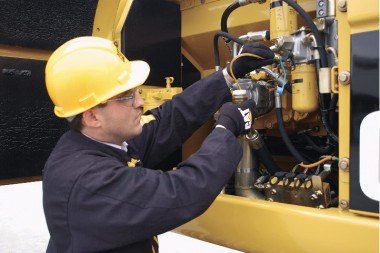 Learning More About Coolant Analysis
Learning More About Coolant Analysis
The low cost way to keep your cooling system trouble-free.
More than 40% of all engine troubles begin with cooling system problems. Once these problems start, they spread through your engine, transmission, and hydraulic system. As a result, power is drained, productivity is decreased, and major breakdowns can occur. Our S-O-S Coolant Analysis detects potential problems before damage occurs. It is a two-level analysis that verifies the proper make-up of your coolant and diagnoses the condition of your cooling system. This allows you to correct coolant deficiencies inexpensively before costly problems arise.
S-O-S Coolant Analysis for Engines
Engines are obviously the most likely to suffer problems from poor cooling system maintenance. More than half of all engine problems are caused or accelerated by poor cooling system maintenance. Within the engine, overheating can contribute to reduced lubricity and rapid deterioration of the oil. This may manifest itself as a component failure (ring and liner wear, bearings, valves, etc.) which masks the fact that cooling system maintenance was a contributing factor.
S-O-S Coolant Analysis for Transmission and Hydraulic Systems
Transmission and hydraulic component life are also dependent upon a properly functioning cooling system. In fact, high oil temperatures can cause early oil deterioration and damage to components in any oil washed system.
During Cat Care seminars, we often advise customers that their hydraulic systems will perform well if they keep them “Clean, Closed, and Cool.” If these three factors are achieved, the hydraulic oil will last until the recommended change period and the system components will last their design life. However, even if the oil is kept clean and closed, it will deteriorate if it is overheated. A poorly maintained cooling system can allow hydraulic oil to overheat, resulting in oxidation, depletion of additives, and loss of lubricity. The result is short pump life, valve wear, and seal failure. S-O-S oil analysis can spot the oil deterioration, but this alone may not identify the cause. S-O-S coolant analysis can determine if the cause of the problem is poor cooling system maintenance.
Similarly, transmission oil can deteriorate as a result of overheating. In transmissions, the process can be accelerated by clutch slippage.
Deterioration of Coolant
The coolant/antifreeze itself deteriorates over time. Overheating accelerates this deterioration. The periodic addition of Supplemental Coolant Additive (SCA) to the standard coolant/antifreeze is intended to replenish the additives (primarily nitrites) which protect the engine parts from corrosion and erosion. If the SCA concentration gets too low, corrosion/erosion will occur, eventually resulting in a pinhole in a cylinder liner, leading to dramatic failure.
However, if the SCA concentration is too great, the silicates and phosphates can precipitate out forming abrasives which cause water pump seal failure. This seal failure allows coolant to enter the engine’s lubrication system. Therefore, it is imperative to achieve a proper balance within the coolant chemistry. Caterpillar Extended Life Coolant eliminates this particular problem.
On-site test strips and quick tests are not fully adequate to assure a safely protected cooling system. Thus, there is a need for a more comprehensive means of analyzing coolant.
Environmental Concerns
Another factor that has focused more attention on coolant is the worldwide emphasis on the environment. Ethylene glycol is extremely hazardous if ingested by humans or animals. Because of this concern, some machine owners operate their coolant longer to reduce the need for disposal. Disposal of used antifreeze can be difficult and expensive.
For all of these reasons, Caterpillar recognized the need to introduce coolant analysis into the S-O-S program.
Two Levels of Analysis
There are two levels to the S-O-S coolant analysis program. The simpler of the two, Level 1, is recommended after every 500 hours of machine operation. Level 2 is recommended every 1,000 hours, or a minimum of once a year or as dictated by Level 1.
Level 1 is a basic coolant maintenance check. It determines if the coolant has the right balance for proper heat and corrosion/erosion control. The tests performed check for glycol level (freeze & boil protection), SCA concentration (corrosion/erosion protection), pH (acid level), and conductivity.
Level 2 is a comprehensive cooling system analysis. It includes all of the Level 1 tests and goes one step further. It completely analyzes the coolant and its effect upon the cooling system. The tests identify metal corrosion, other contaminants, and built-up impurities which point to corrosion and scaling problems before they lead to more costly repairs. Contact your nearest Cat dealer for more details.
